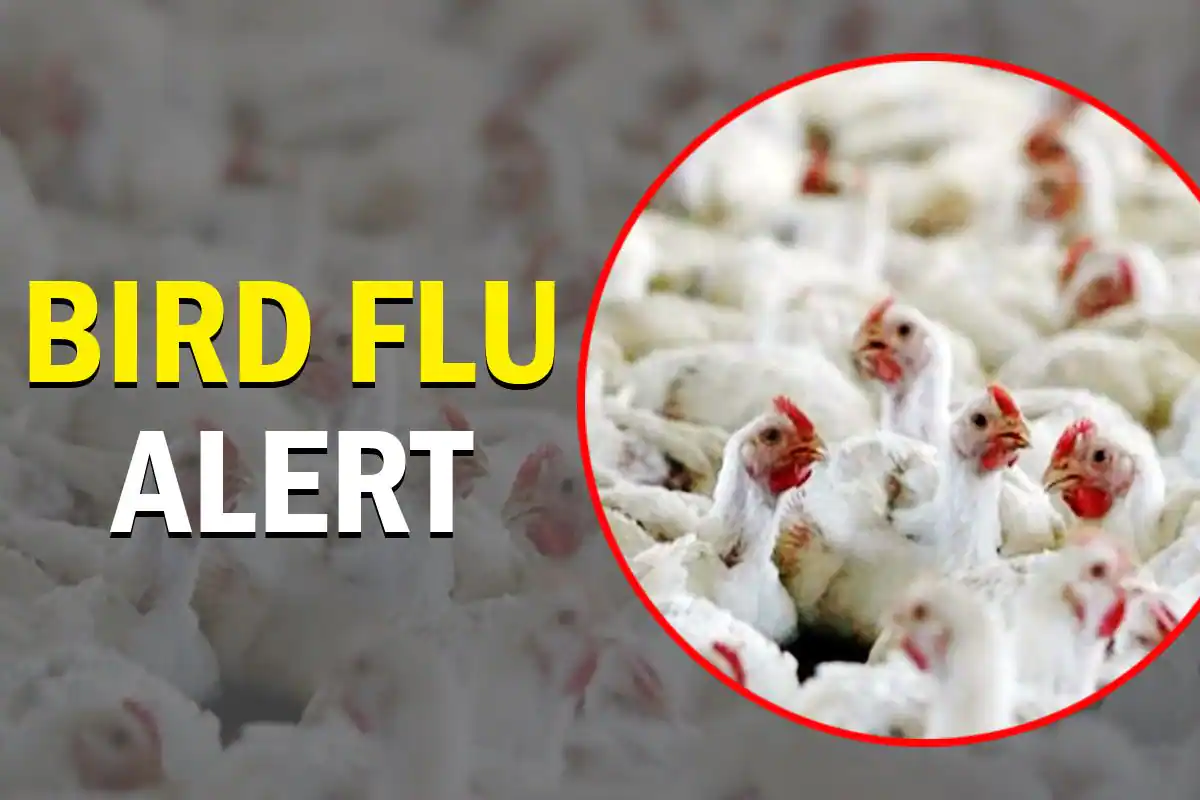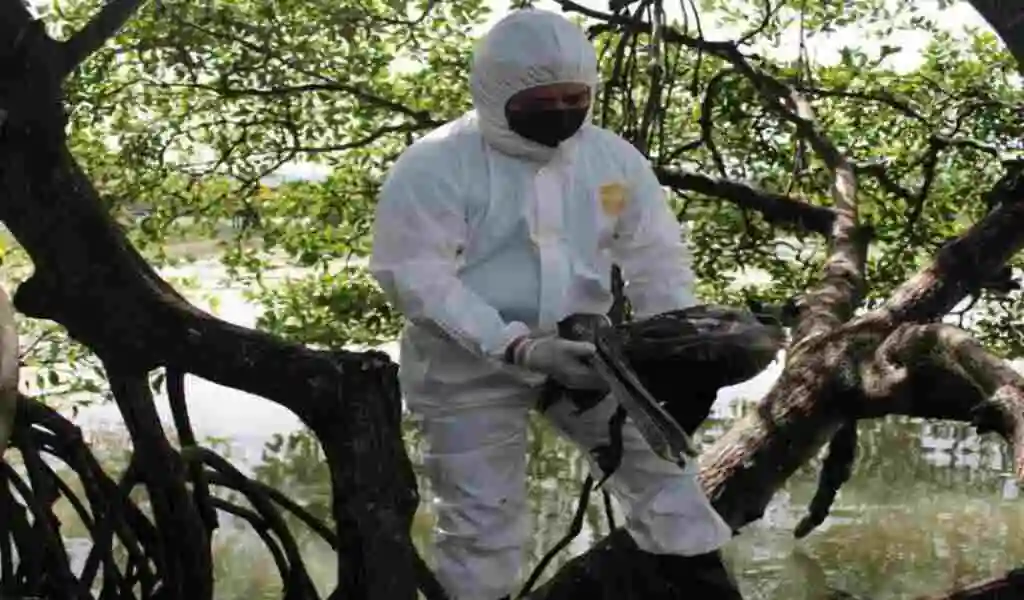News
Avian Influenza Outbreaks in Asia: Updates on H5N6, H5N1, and H5N5 Strains in Poultry

(CTN News) – Japan confirmed the first finding of the H5N6 subtype of the highly pathogenic avian influenza (HPAI) virus in poultry in six years, and South Korea has verified other outbreaks.
The virus was verified after a few birds perished from two connected flocks of roughly 14,000 grill breeders, according to an official report to the World Organisation for Animal Health (WOAH).
The two flocks were epidemiologically related in Minamisatsuma, Kagoshima prefecture. The source of the infection remains unknown.
The ninth HPAI epidemic of the season occurred in Kyushu, the country’s southwestern main island.
A few days ago, the Japanese government reported two more HPAI outbreaks in poultry connected to the H5N1 HPAI virus.
At the end of January, several of the 24 birds in a backyard flock tested positive for the virus. A facility in Yamaguchi Prefecture, western Honshu, was affected.
Soon after, the virus was verified in over 103,700 birds on two epidemiologically connected farms in Kagawa. This prefecture is situated on Shikoku, a huge island south of Honshu.
In addition to the recently found H5N6 virus, Japan has reported eight HPAI outbreaks in poultry this winter, which are attributable to the H5N1 serotype.
Since November, illness caused by the H5N1 virus strain has affected around 654,000 chickens in Japan.
Japanese officials have also reported WOAH cases in wild birds that tested positive for the H5N1, H5N5, and H5N6 serotypes.

Six more poultry outbreaks in Taiwan.
In their most recent statement, Taiwanese authorities reported five new H5N1 outbreaks to WOAH.
All of this began in January and affected farms in Yunlin County. There were two flocks of meat ducks, local hens, and one of meat geese.
Since November of last year, the region has had ten breakouts. Over 91,000 commercial poultry were directly harmed.
Taiwan News stated that approximately 9,600 native chickens were culled in Pingtung County. Following a surge in mortality, they tested positive for the same viral variety.
HPAI strikes Cambodian village flocks again.
Following a brief respite, the H5N1 HPAI virus has been discovered in Cambodian village poultry.
According to WOAH, birds tested positive for the virus in the southern province of Prey Veng on January 24. By the first week of February, two other outbreaks had been verified, one in the northwestern province of Siem Riep and the other in Kratie in the country’s northeast. So far, the number of backyard poultry implicated has exceeded 3,900.
The previous outbreak involving the same virus type was declared in January. It affected approximately 3,000 poultry in six rural flocks across five provinces, including Prey Veng and Siem Riep.
Outbreaks at two South Korean chicken farms.
South Korea reported its first instances of HPAI linked to the H5N6 virus serotype in poultry in December 2018.
The total number of outbreaks in this population has climbed to 26, with WOAH receiving notifications of the most recent two outbreaks among commercial ducks. The impacted buildings had 10,000 birds in South Jeolla and 29,000 in South Chungcheong. There have been past incidents in both provinces.
Around the same period, South Korea experienced its first HPAI outbreaks connected to the H5N1 virus of the winter season.
So far, this serotype has been found on five farms, increasing the overall number of HPAI cases this season to 31. These have directly impacted over 2.08 million commercial poultry.
Avian flu developments in poultry elsewhere in Asia.
After a five-month hiatus, the H5N1 HPAI virus was again identified in the Sakhalin region of Russia’s Far Eastern federal district.
The WOAH notice confirmed the existence of the virus after over 107,000 birds died from a flock of over 294,000. The source of the infection is uncertain.
Sakhalin is a vast island in northeastern Asia.
Last week, India Today reported that HPAI was found in two towns in Andhra Pradesh following the deaths of thousands of poultry. Chicken businesses within a 10-kilometre radius of the outbreaks were closed immediately.
A Times of India report revealed the existence of the H5N1 virus serotype in Nellore district. Rearing chickens in the two outbreak epicentres has been forbidden for three months. After that, flock sizes will be limited to 20 birds.

The Philippines’ animal health ministry has reported seven HPAI cases in poultry in Central Luzon linked to the H5N1 virus to WOAH.
From June 11 to November 30, there were six outbreaks in private flocks and one on a farm. Each outbreak affected flocks of 5–9,000 birds.
Since January 2022, WOAH has received reports of 256 outbreaks impacting about 2.1 million chickens in the Philippines.
Additional human cases in Cambodia, Laos market closed
Cambodia’s health office reported two cases of human infection with the avian influenza A(H5N1) virus to the World Health Organisation earlier this month.
Both began in January. A three-year-old kid from the southern province of Prey Veng began experiencing symptoms on January 1. Later that month, the virus was found in a 69-year-old man from Siem Reap, located in the country’s northwest.
Earlier this month, AvianFluDiary reported another human instance of an avian virus. This concerned a nine-year-old kid from the northeastern region of Kratie, who died from the virus. Investigations found that several of the family’s hens and ducks had died and been devoured.
Cambodia has already had nine cases of this virus in less than a year. This is the highest total achieved by any country in a single year since 2015.
According to the same source, all eight previous occurrences in the country were associated with the 2.3.2.1c clade, an earlier form that existed before the present dominating clade, 2.3.4.4b.
In Laos, a live bird market in the capital city of Vientiane was briefly closed earlier this month.
FluTrackers reported the discovery of H5N1 and H9N2 viruses in chicken, duck, and ambient samples on the grounds.
China reports. avian Influenza virus co-infection.
In Asia, an uncommon case has been reported in China.
A 63-year-old woman from the Xuancheng region of Anhui province became ill at the end of November and died the following month. According to FluTrackers, she was infected with the seasonal flu virus (H3N2) and avian H10N5 strain, as reported in People’s Daily.
The patient was a farmer with underlying medical issues. A few days before the symptoms appeared, she purchased a duck from a live bird market. The meal’s remains tested positive for the H10N5 virus.
According to the World Health Organisation, avian influenza A(H10) subtype viruses can be found in birds worldwide. They are classified as “low pathogenic” for domestic and wild species. They have been known to infect mammals like pigs on rare occasions, but human infections have been extremely rare.

News
Google’s Search Dominance Is Unwinding, But Still Accounting 48% Search Revenue

Google is so closely associated with its key product that its name is a verb that signifies “search.” However, Google’s dominance in that sector is dwindling.
According to eMarketer, Google will lose control of the US search industry for the first time in decades next year.
Google will remain the dominant search player, accounting for 48% of American search advertising revenue. And, remarkably, Google is still increasing its sales in the field, despite being the dominating player in search since the early days of the George W. Bush administration. However, Amazon is growing at a quicker rate.
Google’s Search Dominance Is Unwinding
Amazon will hold over a quarter of US search ad dollars next year, rising to 27% by 2026, while Google will fall even more, according to eMarketer.
The Wall Street Journal was first to report on the forecast.
Lest you think you’ll have to switch to Bing or Yahoo, this isn’t the end of Google or anything really near.
Google is the fourth-most valued public firm in the world. Its market worth is $2.1 trillion, trailing just Apple, Microsoft, and the AI chip darling Nvidia. It also maintains its dominance in other industries, such as display advertisements, where it dominates alongside Facebook’s parent firm Meta, and video ads on YouTube.
To put those “other” firms in context, each is worth more than Delta Air Lines’ total market value. So, yeah, Google is not going anywhere.
Nonetheless, Google faces numerous dangers to its operations, particularly from antitrust regulators.
On Monday, a federal judge in San Francisco ruled that Google must open up its Google Play Store to competitors, dealing a significant blow to the firm in its long-running battle with Fortnite creator Epic Games. Google announced that it would appeal the verdict.
In August, a federal judge ruled that Google has an illegal monopoly on search. That verdict could lead to the dissolution of the company’s search operation. Another antitrust lawsuit filed last month accuses Google of abusing its dominance in the online advertising business.
Meanwhile, European regulators have compelled Google to follow tough new standards, which have resulted in multiple $1 billion-plus fines.

Pixa Bay
Google’s Search Dominance Is Unwinding
On top of that, the marketplace is becoming more difficult on its own.
TikTok, the fastest-growing social network, is expanding into the search market. And Amazon has accomplished something few other digital titans have done to date: it has established a habit.
When you want to buy anything, you usually go to Amazon, not Google. Amazon then buys adverts to push companies’ products to the top of your search results, increasing sales and earning Amazon a greater portion of the revenue. According to eMarketer, it is expected to generate $27.8 billion in search revenue in the United States next year, trailing only Google’s $62.9 billion total.
And then there’s AI, the technology that (supposedly) will change everything.
Why search in stilted language for “kendall jenner why bad bunny breakup” or “police moving violation driver rights no stop sign” when you can just ask OpenAI’s ChatGPT, “What’s going on with Kendall Jenner and Bad Bunny?” in “I need help fighting a moving violation involving a stop sign that wasn’t visible.” Google is working on exactly this technology with its Gemini product, but its success is far from guaranteed, especially with Apple collaborating with OpenAI and other businesses rapidly joining the market.
A Google spokeswoman referred to a blog post from last week in which the company unveiled ads in its AI overviews (the AI-generated text that appears at the top of search results). It’s Google’s way of expressing its ability to profit on a changing marketplace while retaining its business, even as its consumers steadily transition to ask-and-answer AI and away from search.

Google has long used a single catchphrase to defend itself against opponents who claim it is a monopoly abusing its power: competition is only a click away. Until recently, that seemed comically obtuse. Really? We are going to switch to Bing? Or Duck Duck Go? Give me a break.
But today, it feels more like reality.
Google is in no danger of disappearing. However, every highly dominating company faces some type of reckoning over time. GE, a Dow mainstay for more than a century, was broken up last year and is now a shell of its previous dominance. Sears declared bankruptcy in 2022 and is virtually out of business. US Steel, long the foundation of American manufacturing, is attempting to sell itself to a Japanese corporation.
SOURCE | CNN
News
2024 | Supreme Court Won’t Hear Appeal From Elon Musk’s X Platform Over Warrant In Trump Case

Washington — Trump Media, The Supreme Court announced Monday that it will not hear an appeal from social media platform X about a search warrant acquired by prosecutors in the election meddling case against former President Donald Trump.
The justices did not explain their rationale, and there were no recorded dissents.
The firm, which was known as Twitter before being purchased by billionaire Elon Musk, claims a nondisclosure order that prevented it from informing Trump about the warrant obtained by special counsel Jack Smith’s team violated its First Amendment rights.
The business also claims Trump should have had an opportunity to exercise executive privilege. If not reined in, the government may employ similar tactics to intercept additional privileged communications, their lawyers contended.
Supreme Court Won’t Hear Appeal From Elon Musk’s X Platform Over Warrant In Trump Case
Two neutral electronic privacy groups also joined in, urging the high court to hear the case on First Amendment grounds.
Prosecutors, however, claim that the corporation never shown that Trump utilized the account for official purposes, therefore executive privilege is not a problem. A lower court also determined that informing Trump could have compromised the current probe.

Trump utilized his Twitter account in the weeks preceding up to his supporters’ attack on the Capitol on January 6, 2021, to spread false assertions about the election, which prosecutors claim were intended to create doubt in the democratic process.
The indictment describes how Trump used his Twitter account to encourage his followers to travel to Washington on Jan. 6, pressuring Vice President Mike Pence to reject the certification, and falsely claiming that the Capitol crowd, which battered police officers and destroyed glass, was peaceful.
Supreme Court Won’t Hear Appeal From Elon Musk’s X Platform Over Warrant In Trump Case
That case is now moving forward following the Supreme Court’s verdict in July, which granted Trump full immunity from criminal prosecution as a former president.
The warrant arrived at Twitter amid quick changes implemented by Musk, who bought the company in 2022 and has since cut off most of its workforce, including those dedicated to combating disinformation and hate speech.
SOURCE | AP
News
The Supreme Court Turns Down Biden’s Government Appeal in a Texas Emergency Abortion Matter.

(VOR News) – A ruling that prohibits emergency abortions that contravene the Supreme Court law in the state of Texas, which has one of the most stringent abortion restrictions in the country, has been upheld by the Supreme Court of the United States. The United States Supreme Court upheld this decision.
The justices did not provide any specifics regarding the underlying reasons for their decision to uphold an order from a lower court that declared hospitals cannot be legally obligated to administer abortions if doing so would violate the law in the state of Texas.
Institutions are not required to perform abortions, as stipulated in the decree. The common populace did not investigate any opposing viewpoints. The decision was made just weeks before a presidential election that brought abortion to the forefront of the political agenda.
This decision follows the 2022 Supreme Court ruling that ended abortion nationwide.
In response to a request from the administration of Vice President Joe Biden to overturn the lower court’s decision, the justices expressed their disapproval.
The government contends that hospitals are obligated to perform abortions in compliance with federal legislation when the health or life of an expectant patient is in an exceedingly precarious condition.
This is the case in regions where the procedure is prohibited. The difficulty hospitals in Texas and other states are experiencing in determining whether or not routine care could be in violation of stringent state laws that prohibit abortion has resulted in an increase in the number of complaints concerning pregnant women who are experiencing medical distress being turned away from emergency rooms.
The administration cited the Supreme Court’s ruling in a case that bore a striking resemblance to the one that was presented to it in Idaho at the beginning of the year. The justices took a limited decision in that case to allow the continuation of emergency abortions without interruption while a lawsuit was still being heard.
In contrast, Texas has been a vocal proponent of the injunction’s continued enforcement. Texas has argued that its circumstances are distinct from those of Idaho, as the state does have an exemption for situations that pose a significant hazard to the health of an expectant patient.
According to the state, the discrepancy is the result of this exemption. The state of Idaho had a provision that safeguarded a woman’s life when the issue was first broached; however, it did not include protection for her health.
Certified medical practitioners are not obligated to wait until a woman’s life is in imminent peril before they are legally permitted to perform an abortion, as determined by the state supreme court.
The state of Texas highlighted this to the Supreme Court.
Nevertheless, medical professionals have criticized the Texas statute as being perilously ambiguous, and a medical board has declined to provide a list of all the disorders that are eligible for an exception. Furthermore, the statute has been criticized for its hazardous ambiguity.
For an extended period, termination of pregnancies has been a standard procedure in medical treatment for individuals who have been experiencing significant issues. It is implemented in this manner to prevent catastrophic outcomes, such as sepsis, organ failure, and other severe scenarios.
Nevertheless, medical professionals and hospitals in Texas and other states with strict abortion laws have noted that it is uncertain whether or not these terminations could be in violation of abortion prohibitions that include the possibility of a prison sentence. This is the case in regions where abortion prohibitions are exceedingly restrictive.
Following the Supreme Court’s decision to overturn Roe v. Wade, which resulted in restrictions on the rights of women to have abortions in several Republican-ruled states, the Texas case was revisited in 2022.
As per the orders that were disclosed by the administration of Vice President Joe Biden, hospitals are still required to provide abortions in cases that are classified as dire emergency.
As stipulated in a piece of health care legislation, the majority of hospitals are obligated to provide medical assistance to patients who are experiencing medical distress. This is in accordance with the law.
The state of Texas maintained that hospitals should not be obligated to provide abortions throughout the litigation, as doing so would violate the state’s constitutional prohibition on abortions. In its January judgment, the 5th United States Circuit Court of Appeals concurred with the state and acknowledged that the administration had exceeded its authority.
SOURCE: AP
SEE ALSO:
Could Last-Minute Surprises Derail Kamala Harris’ Campaign? “Nostradamus” Explains the US Poll.
-

 News4 years ago
News4 years agoLet’s Know About Ultra High Net Worth Individual
-
Entertainment2 years ago
Mabelle Prior: The Voice of Hope, Resilience, and Diversity Inspiring Generations
-
News11 years ago
Enviromental Groups Tell Mekong Leaders Lao Dam Evaluation Process Flawed
-

 Health4 years ago
Health4 years agoHow Much Ivermectin Should You Take?
-

 Tech3 years ago
Tech3 years agoTop Forex Brokers of 2023: Reviews and Analysis for Successful Trading
-

 Lifestyles3 years ago
Lifestyles3 years agoAries Soulmate Signs
-

 Entertainment3 years ago
Entertainment3 years agoWhat Should I Do If Disney Plus Keeps Logging Me Out of TV?
-

 Health3 years ago
Health3 years agoCan I Buy Ivermectin Without A Prescription in the USA?


